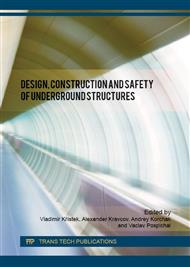p.36
p.45
p.51
p.59
p.65
p.72
p.81
p.87
p.93
Improving the Efficiency of Artificial Ground Freezing in Urban Underground Construction by Using Solid Carbon Dioxide
Abstract:
At the present time there are several basic methods of soils characteristics increase during the underground structures construction. Though, frequently the ground freezing method is the most efficient way. Modern Russian investigations show, that in case of small values of frozen grounds (less than 1000 m3) the cost of construction works significantly increase. In such conditions the relevant construction technology is a ground freezing method with the use of solid carbon dioxide, which nowadays is under development in the Mining College in National University of Science and Technology MIS&S.The present article shows the brief review of the main manufacturing schemes of the ground freezing, results of the new theories and experimental investigations, also the analysis of a commercial introduction experience of the ground freezing technology with the using of carbon dioxide.So far, the main difficulties during freezing process design were with the determination of a heat flow to the freezing pipe`s direction. It was not possible to predict the dynamic of ice wall formation and the discharge of carbon dioxide. According to the last investigations, we were succeed in determinating the change dependence of the heat dissipation, depending on the rock massive characteristics, granulometric composition of solid carbon dioxide and also its changing along the freezing pipe. That is why, now we may say that, the developing technology became not just a laboratory workout, but can already has a widespread adoption in praxis
Info:
Periodical:
Pages:
65-71
Citation:
Online since:
July 2016
Authors:
Price:
Сopyright:
© 2016 Trans Tech Publications Ltd. All Rights Reserved
Share:
Citation:


